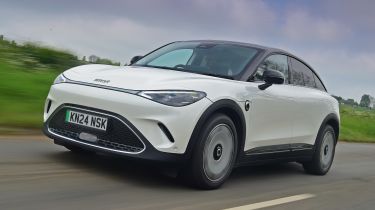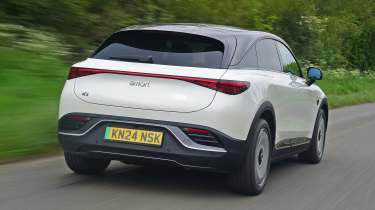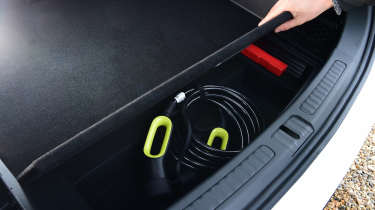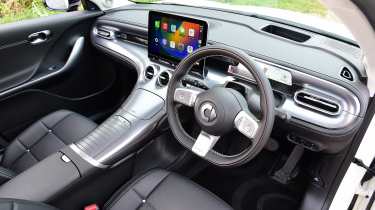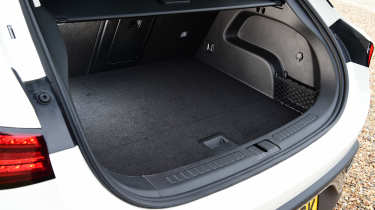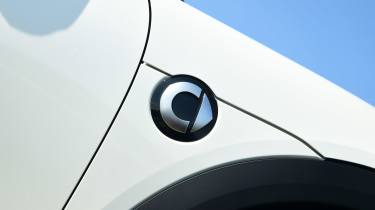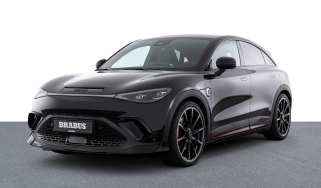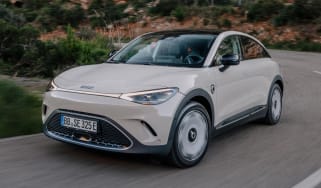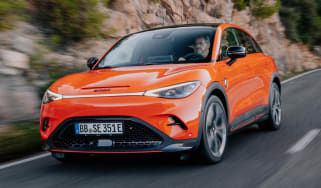Smart #3 review: a quirky and fun electric car
The Smart #3 is a practical mid-size coupe-SUV that’s great to drive but with annoying infotainment and quality issues

Quick verdict
The Smart #3 is an interesting new choice in the electric car market. It stands out visually, the driving experience is a treat and it should cater to most families' needs. We’re looking forward to seeing more cars from Smart – especially on this architecture – but we have our concerns over build quality inside, and the infotainment system remains nonsensical.
|
Key specs | |
|
Fuel type |
Electric |
|
Body style |
Five-door coupe-SUV |
|
Powertrain |
62kWh battery/1x e-motor |
|
Safety |
5-star EuroNCAP (2023) |
|
Warranty |
2yrs/unlimited mileage |
Smart #3: price, specs and rivals
Say the words ‘Smart car’ and most people will still think of the cleverly-packaged, tiny two seaters that Smart made for over two decades – up until the ForTwo’s demise early in 2024. Now, the company has shifted onto bigger, and what it hopes will be better, things. The brand’s new focus on all-electric cars started with the Smart #1, and that’s now been joined by this Smart #3.
The Smart #3 currently sits at top of Smart’s two-strong range, although it’ll soon be joined by the larger, more traditionally-styled Smart #5 SUV.
Both the #1 and #3 sit on the brand’s Sustainable Experience Architecture or SEA for short. This platform comes from Smart’s parent company, Geely and can also be found under the Volvo EX30. The Smarts get a different battery set-up to their Swedish cousin, however, with the #3 in basic Pro guise offered with a 47kWh battery, and the Pro+, Premium and hot Brabus versions all receiving a 62kWh unit. Aside from the dual-motor Brabus, every Smart #3 has a single-motor on the rear axle with 268bhp and 343Nm of torque.
Used - available now

2016 BMW
5 Series
107,200 milesAutomaticDiesel2.0L
Cash £9,000
2023 Audi
e-tron
48,154 milesAutomaticElectric
Cash £18,000
2015 Volkswagen
Golf GTD
84,621 milesAutomaticDiesel2.0L
Cash £12,000
2016 Tesla
Model S
78,000 milesAutomaticElectric
Cash £18,999You might think the sleek exterior and eye-catching interior of the #3 wouldn’t look out of place within Mercedes’ range of all-electric cars and there’s a good reason for that. Smart is owned by Chinese firm Geely and partly by Mercedes, too. Mercedes’ Chief Design Officer, Gorden Wagener, even signed off on the #3’s design.
It’s difficult to place the #3 into a specific market sector as its bespoke coupe-SUV bodystyle and interior space help it to span a number of different segments. It’s around the same width and height as a Volkswagen ID.3, but 140mm longer. Other potential rivals include the Renault Megane E-Tech, Cupra Born, Kia Niro EV, Mercedes EQA and of course the Smart’s Volvo EX30 relative.
At around £33,000 for the small battery model and around £36,000 for the larger battery cars, the #3 certainly targets those aforementioned cars in terms of pricing (£45,000 Brabus model aside).
Smart has decided to keep the range of options relatively slim for the #3 (customers can choose paint finishes and interior trim only). Don’t worry though, the #3 is well-equipped as standard. The entry-level Pro gets a panoramic sunroof, automatic LED headlights, a 360-degree camera, 19-inch wheels, heated front seats and a powered bootlid. The 12.8-inch central infotainment screen and 9.2-inch driver’s display are standard across the range. Other neat touches include frameless windows and flush-fitting doors handles.
The Pro+ adds Smart’s ‘Pilot Assist’ safety system, synthetic leather seats and wireless smartphone charging. The Premium adds 19-inch alloy wheels, a 10-inch head-up display, an uprated sound system, automatic parking assist and a heat pump. As for the 25th Anniversary Edition, it receives a ‘Galaxy panoramic sunroof’ and Brabus-style bodykit.
The Brabus model with its extra electric motor has a higher focus on performance. Alongside the exterior tweaks, that include bespoke 20-inch wheels, red painted brake calipers, red accents and revised bumpers front and rear, there are also ventilated seats with red trim, a sports steering wheel, red seat belts and plenty of Brabus badging inside.
Electric motor, performance & drive
|
Smart #3 Pro |
268bhp |
5.8 secs |
112mph |
|
Smart #3 Premium |
268bhp |
5.8 secs |
112mph |
|
Brabus #3 |
422bhp |
3.7 secs |
112mph |
From our time with the Volvo EX30, we expected the Smart #3 to be pretty competent when you get behind the wheel, given the shared SEA underpinnings. Smart, however, has somehow managed to deliver a genuinely enjoyable driving experience with this coupe-SUV that exceeds our expectations.
Jumping into the Smart #3 you immediately notice you’re in a sleeker car than the #1 with a lower, more driver-focused seating position. Smart has stiffened the springs and dampers, so the ride is a little firmer than in the #1, too.
Like most EVs the initial punch is super impressive and it feels like none of the rear motor’s 268bhp is going to waste through the rear tyres, which are pretty wide for a mainstream electric car. It’s obvious when the power tails off at higher speeds but overall the acceleration is smooth and linear throughout.
Despite weighing in at a not insignificant 1,710kg there’s some fun to be had with the #3 in the bends. With slightly vague steering, there’s a little bit of guesswork to be done when you do decide to throw it around. There’s not much adjustability in the steering, but body roll is well contained, and while the initial bite from the brakes could be sharper, there’s a rhythm to be found with the Smart. In a lot of ways it reminds us of the MG4, which is no bad thing.
Squeeze the throttle and the #3 feels decidedly rear-driven in the bends - especially if you turn off the ESC. Traction control is never fully off in the #3 but if you’re keen with the throttle you’ll find a little bit of slip from the rear - despite the car wearing rather wide tyres for a family EV.
The selection of driving modes (Eco, Comfort and Sport) don’t drastically change the driving experience, and we’re not huge fans of the brake regeneration system, which feels laboured in the all important transition between accelerator-pedal lift-off and the recuperation kicking in. The ‘E-Pedal’ mode is meant to provide a stronger braking sensation, but it’s still not quite one-pedal driving.
Ride comfort levels are generally decent. One thing that didn’t show up during our initial drive on silky smooth Spanish roads was the tyre roar, which is more noticeable on rougher UK surfaces than we’d like. The suspension also seemed to clatter around on poor surfaces – although it was strange to find big speed bumps smothered pretty effectively. Either way, we don’t think the firm feel is enough of a dealbreaker to steer you away from the fabulous-looking 19-inch monobloc-style alloy wheels. Wind noise is kept to a minimum, even at higher speeds.
We’ve driven the Brabus version too and while it obviously aims to create a more performance-focused driving experience, we didn’t find it any more fun. The 0-62mph time of 3.7 seconds is impressive, but we think you’d get tired of this party piece pretty quickly. Bigger brakes and stiffer suspension don’t equate to better feel behind the wheel either and that extra motor on the front axle adds an extra 100kg to the weight of the car. There’s a tremendous amount of grip, but the Brabus is very much a point and squirt sort of car, rather than showing the agility to make corners fun.
0-60 acceleration and top speed
The Smart comes with two powertrain layouts. The rear-wheel drive, single-motor version has 268bhp and 343Nm of torque, while the dual-motor arrangement you find on the Brabus has 422bhp and 543Nm of torque.
Both the 47kWh battery and the 62kWh battery go from 0-62mph in 5.8 seconds with the same electric motors. The Brabus has almost supercar-like acceleration, taking just 3.7 seconds to complete the sprint. All #3s are limited to a 111mph top speed.
Range, charging & running costs
Smart claims a driving range up to 283 miles in the Smart #3 Premium and the 25th Anniversary Edition. The Pro+ comes with a 270-mile range with the difference down to the former two trim levels getting a heat pump. The Pro with its smaller battery only manages a 202-mile range and the Brabus with its less efficient powertrain and heavier kerb weight will do 258 miles on a charge.
A 3.6kWh efficiency figure is claimed for all the 62kWh battery models (Brabus aside), which isn't bad for this size of car. The Smart’s sleek, curvaceous bodywork most likely helps it from an aerodynamic perspective and during our test we got pretty close to the claimed efficiency figure with 3.5kWh.
You can top-up the 49kWh (47kWh useable) and 66kWh (62kWh useable) versions from 10-80 per cent charge in around 30 minutes. The smaller pack will take up to 130kW of charge, while the larger one will take up to 150kW.
Most will probably use cheaper overnight electricity and charge up using a 7.4kW wallbox charger at home. The smaller battery pack will take up to 7.5 hours to fully recharge, while the larger capacity battery will take up to 10 hours to refill a flat battery.
With zero emissions the #3 has a Benefit-in-Kind (BIK) company car tax band of two per cent, at least until 2025.
Smart wants to establish itself as a premium brand and this unfortunately shows when it comes to insurance. The #3 sits in relatively high groups of 33 ranging to 41. The cheapest Cupra Borns, for example, are in group 25.
It’s still too early to say how the #3 or even its #1 sibling with fare when it comes to depreciation. The old Smart ForTwo managed to keep hold of 47 per cent over three years or 36,000 miles, but the #1 and #3 wildly different propositions.
Design, interior & technology
Mercedes had input on the exterior design of the Smart #3 and the car has more than a whiff of the German firm inside, too. The shape of the centre console feels like it could come from a previous-generation Mercedes C-Class and small things like window switches, air vents and even the fonts all feel very Mercedes-like.
This is no bad thing, it gives the Smart a premium look which is backed up by a spacious, airy cabin. The curved exterior design is carried over to the inside - pretty much everything is round and while its a minimalist layout - the #3’s interior certainly isn’t dull.
Our car’s panoramic roof added to the bright, welcoming interior. Despite that coupe-like roofline, there’s loads of headroom in the back thanks to seats that have been positioned lower than the Smart #1’s.
Yet the #3’s interior all feels a little superficial once you prod around inside. During our time with the car a rattle from the centre console seemed only fixable by having the storage lid in the up position, and the plastics dotted around the cabin felt flimsy.
Technology is a strong suit of the #3 with wireless smartphone charging, heated front seats, four USB ports and a 360-degree camera all standard. The Premium seems like its worth the extra outlay with its uprated sound system, head-up display (which we didn’t find intrusive) and heat pump. The ambient lighting seemed a bit ostentatious because the speakers on the A-pillar were backlit and were pretty noticeable even from outside the car.
Sat-nav, stereo and infotainment
The 12.8-inch central screen and 9.2-inch instrument cluster (standard on all models) both have a great resolution, but we found them slow to respond, and in a couple of instances the sat-nav froze completely while driving. That infotainment system is a real chore to navigate, too, with a main menu overburdened with menus and apps. We have a feeling most will exclusively use Apple CarPlay or Android Auto instead.
Boot space, comfort & practicality
|
Dimensions | |
|
Length |
4,400mm |
|
Width |
1,844mm |
|
Height |
1,556mm |
|
Number of seats |
Five |
|
Boot space |
370 litres |
The Smart #3 is longer and wider than the #1, but it’s lower as well. You wouldn’t think that sitting inside, though, because there’s loads of room both up front and in the back seats. There’s plenty of cabin storage with large door bins and a spacious centre console.
The relatively low dash in the #3 means forward visibility is great. The shape of the rear window means you have a slightly narrower rear view than you’d like, but it’s no deal-breaker. We also found the seats to be perfectly comfortable with their man-made leather upholstery. The Brabus gets the same shape seating with extra ‘B’ logos and a microfibre finish.
A 370-litre boot is a decent size considering there’s an electric motor beneath it - it’s also 43 litres more than you get in the #1 due to the Smart #3’s extra length. There’s a bit of a lip to the boot as well, but the #3 has a false floor that you can raise to make this completely flush and underneath there’s a large storage area for cables.
Premium trim receives a gesture-control bootlid, although ours only managed to open half way when using this feature. The sloping shape of the roofline means large dogs may not be well-suited to the Smart #3’s boot.
Safety & reliability
|
Key standard safety features |
Euro NCAP safety ratings |
|
Smart didn’t feature in our 2023 Driver Power customer satisfaction survey and it’s too early to say how customers are getting on with their #1s just yet, let alone the newer Smart #3 model.
All Smart cars come with an unusually short two-year, unlimited mileage warranty. The battery warranty is about average for the industry with eight years or 125,000 miles - whichever comes first. Core components such as the electric motor are limited to eight years and 100,000 miles.
Euro NCAP tested the #3 in 2023 and like the #1 it received the full five star rating. Adult occupancy was especially strong in a crash with a 90 per cent score, child occupant was 86 per cent, safety systems got an 85 per cent rating and pedestrian safety was 84 per cent.
Recommended servicing intervals for the Smart #3 haven’t been announced yet, but we doubt it’ll differ much from the two years or 20,000 mile intervals of its sibling, the Smart #1.
Should you buy a Smart #3?
The Smart #3 is an appealing choice in an increasingly tight electric SUV market. It exterior and interior design certainly help it stand out, but the driving experience is arguably the #3’s greatest asset. It’s keenly priced too, although we have our doubts over general build quality. As only the second new car under Smart’s new electric era, the #3 shows the brand has a bright future.
Frequently Asked Questions
You get eight years or 125,000 miles on the battery pack, but just two years and unlimited mileage for the rest of the car.

